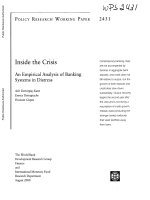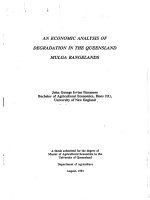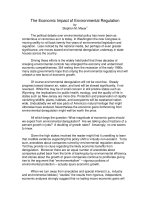economic analysis of banking regulation
Bạn đang xem bản rút gọn của tài liệu. Xem và tải ngay bản đầy đủ của tài liệu tại đây (309.89 KB, 29 trang )
Copyright 2011
Pearson Canada Inc.
10-
1
Chapter 10
Economic Analysis of
Banking Regulation
Copyright 2011
Pearson Canada Inc.
10-
2
Asymmetric Information and Bank Regulation I
•
Government safety net: Deposit insurance and
the CDIC
–
Short circuits bank failures and contagion effect
–
Payoff method
–
Purchase and assumption method
•
Government can support banks through lending
from the central bank
–
“Lender of Last Resort” role for central bank
–
Government can provide funds directly to
institutions in need
Copyright 2011
Pearson Canada Inc.
10-
3
Asymmetric Information and Bank Regulation II
•
Moral Hazard
–
Depositors do not impose discipline of marketplace
–
Banks have an incentive to take on greater risk
–
“Heads I win, tails the taxpayer loses”
•
Adverse Selection
–
Risk-lovers find banking attractive
–
Depositors have little reason to monitor bank
Copyright 2011
Pearson Canada Inc.
10-
4
Too Big to Fail
•
Failure of very large financial institution makes it
more likely that major financial disruption will occur
•
Regulators unwilling to let large institutions fail
•
Government provides guarantees of repayment to
large uninsured creditors of the largest banks which
reduces investors incentive to monitor banks
activities
•
Increases moral hazard incentives for big banks
making a financial crisis more likely
Copyright 2011
Pearson Canada Inc.
10-
5
Financial Consolidation
•
Larger and more complex banking
organizations challenge regulation
–
Increased “too big to fail” problem
–
Extends safety net to new activities, increasing
incentives for risk taking in these areas
Copyright 2011
Pearson Canada Inc.
10-
6
Restrictions on Asset Holding
•
Even without government intervention banks have
incentive to take more risk as risky assets provide
higher returns.
•
Full information to creditors/depositors on banks
risk-taking activities might mitigate problem.
•
Government regulation directly attempts to restrict
banks from too much risk taking
–
Restrict holdings of common stock
–
Promote diversification
Copyright 2011
Pearson Canada Inc.
10-
7
Capital Requirements
•
Government can impose set capital
requirements
–
Minimum leverage ratio (amount of capital
divided by the bank’s total assets)
•
Increase in off balance sheet activities a
concern
–
Basel Accord: risk-based capital requirements
–
Regulatory arbitrage
Copyright 2011
Pearson Canada Inc.
10-
8
Financial Supervision: Chartering and
Examination
•
Chartering (screening of proposals to open new banks)
to prevent adverse selection
•
Examinations (scheduled and unscheduled) to monitor
capital requirements and restrictions on asset holding to
prevent moral hazard
–
Capital adequacy
–
Asset quality
–
Management
–
Earnings
–
Liquidity
–
Sensitivity to market risk
•
Filing periodic ‘call reports’
Copyright 2011
Pearson Canada Inc.
10-
9
Assessment of Risk Management
•
Greater emphasis on evaluating soundness of
management processes for controlling risk
•
Focus is four elements of risk management
–
Quality of oversight provided
–
Adequacy of policies and limits
–
Quality of the risk measurement and monitoring systems
–
Adequacy of internal controls
•
Interest-rate risk limits
–
Internal policies and procedures
–
Internal management and monitoring
–
Implementation of stress testing and Value-at risk (VAR)
Copyright 2011
Pearson Canada Inc.
10-
10
Disclosure Requirements
•
Requirements to adhere to standard
accounting principles and to disclose wide
range of information
•
Eurocurrency Standing Committee of the G-10
Central Banks also recommends estimates of
financial risk generated by the firm’s internal
monitoring system be adapted for public
disclosure
Copyright 2011
Pearson Canada Inc.
10-
11
Consumer Protection
•
Requires lenders to provide information to
consumers on the costs of borrowing
(including a standardized interest rate)
•
Requires provision of information on the
method of assessing finance charges
•
Requires that billing complaints be handled
quickly
Copyright 2011
Pearson Canada Inc.
10-
12
Restrictions on Competition
•
Justified by moral hazard incentives to take on
more risk as competition decreases
profitability
•
Disadvantages
–
Higher consumer charges
–
Decreased efficiency
Copyright 2011
Pearson Canada Inc.
10-
13
International Banking Regulation
•
Similar to Canada
–
Chartered and supervised
–
Deposit insurance
–
Capital requirement
•
Particular problems
–
Easy to shift operations from one country
to another
–
Unclear jurisdiction lines
Copyright 2011
Pearson Canada Inc.
10-
14
The 1980s Canadian Banking Crisis I
•
Mid 1980s Canadian Commercial and Northland
banks in Alberta failed and a large number of other
institutions were having financial difficulties
Reasons:
1. Managers did not have the required expertise to
manage risk
2. The existence of CDIC, more opportunities for risk
taking
Copyright 2011
Pearson Canada Inc.
10-
15
The 1980s Canadian Banking Crisis II
3. Because of the lending boom, bank activities were
becoming more complicated. Regulators had neither
the expertise nor the resources to monitor these
activities appropriately
4
.
inflation ↑ interest rates ↑, net worth of banks ↓
-
Insolvencies ↑
-
Incentives for risk taking ↑
Result: Failures ↑ and risky loans ↑
Copyright 2011
Pearson Canada Inc.
10-
16
The 1980s Canadian Banking Crisis III
Later Stages: Regulatory Forbearance
Regulators allow insolvent banks to operate because
A. Insufficient funds to close insolvent banks and pay
off their deposits
B. Sweep problems under rug
Insolvencies caused further banking difficulties
Copyright 2011
Pearson Canada Inc.
10-
17
CDIC Developments I
•
CDIC insures each depositor at member
institutions up to a loss of $100 000 per
account
•
All federally incorporated financial institutions
and all provincially incorporated TMLs are
members of the CDIC
•
Insurance companies, credit unions, caisses
populaires, and investment dealers are not
eligible for CDIC
Copyright 2011
Pearson Canada Inc.
10-
18
CDIC Developments I
•
CDIC insures each depositor at member institutions up to
a loss of $100 000 per account
•
All federally incorporated financial institutions and all
provincially incorporated TMLs are members of the CDIC
•
Insurance companies, credit unions, caisses populaires,
and investment dealers are not eligible for CDIC
Copyright 2011
Pearson Canada Inc.
10-
19
CDIC Developments II
•
QDIB insures provincially incorporated institutions in
Québec and the other provinces have deposit
insurance corporations that insure the deposits of
credit unions
•
Not all deposits and investments offered by CDIC
member institutions are insurable
Copyright 2011
Pearson Canada Inc.
10-
20
Not All Deposits Are Insurable
Insurable deposits include
•
Savings and chequing accounts
•
Term deposits with a maturity date < 5 years
•
Money orders and drafts, certified drafts and cheques, and
traveller’s cheques
The CDIC does not insure
•
Foreign currency deposits or term deposits with maturity date
> 5 years
•
T-bills, bonds and debentures issued by governments and
corporations (including the chartered banks)
•
Investments in stocks, mutual funds, and mortgages.
Copyright 2011
Pearson Canada Inc.
10-
21
Differential Premiums
•
Differential premiums means investments with
differing risk profiles are subject to different
insurance premiums
•
Premium categories range from 1 (best) for a well
capitalized bank, to 4 (worst) for a significantly
under capitalized bank
Copyright 2011
Pearson Canada Inc.
10-
22
Opting-Out I
•
Permits Schedule III banks, that accept primarily
wholesale deposits (defined as $150 000 or more), to
opt out of CDIC membership and therefore to operate
without deposit insurance
•
It requires, however, an opted-out bank to inform all
depositors, by posting notices in its branches, that their
deposits will not be protected by the CDIC, and not to
charge any early withdrawal penalties for depositors
who choose to withdraw
Copyright 2011
Pearson Canada Inc.
10-
23
Opting-Out II
Implications:
•
Minimizes CDIC exposure to uninsured deposits
•
By compensating only the insured depositors rather than
all depositors, this legislation increases the incentives of
uninsured depositors to monitor the risk-taking activities
of banks, thereby reducing moral hazard risk
Copyright 2011
Pearson Canada Inc.
10-
24
Evaluating CDIC I
Limits on Scope of Deposit Insurance
1. Eliminate deposit insurance entirely
2. Lower limits on deposit insurance
3. Eliminate too-big-to-fail
4. Coinsurance
Prompt Corrective Action
1. Critics believe too many loopholes
2. However: accountability increased by mandatory
review of bank failure resolutions
Copyright 2011
Pearson Canada Inc.
10-
25
Evaluating CDIC II
Risk-based Insurance Premiums
- Scheme for determining risk, it is accurate?
Other CDIC Provisions
- Regulators perform frequent examinations
- Gives CDIC discretion in examining performance of
problem institution
Other Proposed Changes
- Regulatory consolidation
- Market-value accounting









